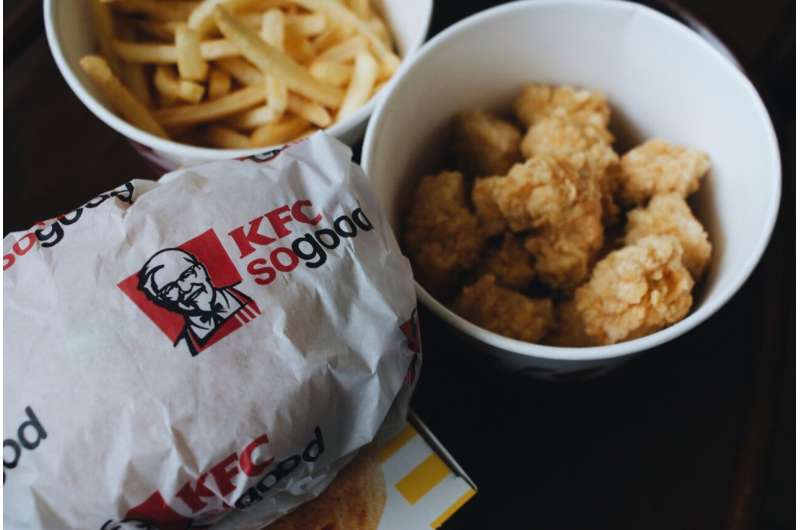Credit: Unsplash/CC0 Public Domain
A team of researchers from Nanyang Technological University, Singapore (NTU Singapore) studying how the acoustic and visual composition of advertisements impact perceptions, has found that consumers associate a higher frequency "sonic logo" with healthier food products.
Sonic logos, also termed sogos, are short melodies created to support the marketing of a specific brand.
The study also linked more stimulating visuals in commercials with consumer perceptions that the food product it was advertising was healthier.
Conversely, consumers tended to associate low-pitched sonic logos and commercials with less vivid designs with unhealthy food products.
The NTU study is timely, as global spending on advertisements is expected to increase 12% to more than US$795 billion by the end of 2022, and the study could aid marketers in selecting the optimal audio-visual elements to best convey their brand identity to consumers.
The study involved 180 participants, who were presented with either fictitious sogos generated by an online Random Music Generator, or visual cues, followed by a pair of images of food products, one healthy and one unhealthy. Participants were asked to select the food that they felt best matched each sogo that they heard, leading them to pair each sogo with a food image.
The food images comprised three healthy foods (green salad, fruit salad, and tomato and cucumber salad) and three unhealthy foods (cheeseburger, French fries, and chocolate cookies).
NTU neuroscientist Professor Gemma Calvert, one of the pioneers of neuromarketing, who led the study, said: "Sensory stimuli, such as sounds and colors, play a prominent role in branding. Sound is the fastest human sense, faster than smell, taste, sight, and even touch. When that is combined with the fact that music invokes emotion in people—a big driver in brand loyalty—the importance of understanding the impact of sound in branding rings crystal clear. Our study has further cemented other research that drew links between the many aspects of an advertisement, providing useful ideas to brand managers and their agencies who are seeking a sensory branding strategy for healthy food products."
Ms. Monin Techawachirakul a Ph.D. student from NTU's Nanyang Business School, who was the study's co-author, said: "We propose that food brand managers that wish to highlight the healthfulness of their products should employ high-frequency sogos to enhance the health appeal of foods, especially if they are products that promote health benefits or serve as healthier options. The effectiveness of sogos can be further augmented by congruent packaging or visual logos that use more vivid designs to prompt consumers into making healthier choices without having to evaluate complex information, often contained in the nutritional labels."
The findings were published in the scientific peer-reviewed journal Food Quality and Preference in March.
In another experiment with sogos, participants were asked to decide between beef burgers and soy burgers, and between healthy salads and unhealthy salads (made so with the addition of fries); the researchers found that the linkage between sogos and perceived healthiness extended to different food items within the same category.
The team also found that the tempo of the audio or sound used in the commercials had little or no impact on consumers' perceptions of whether the food products were healthy. However, the researchers say that tempo could be linked to other food-related behaviors, for example, during dining, playing faster-paced music could influence consumers to chew their food quicker.
Explaining their findings, the researchers said the association between high-frequency stimuli and the healthiness of food could be the shared semantic association between the features of frequency and food stimuli.
Prof. Calvert, who is from NTU's Nanyang Business School, added: "We assume that high-frequency sogos and healthiness are matched because high pitched sounds and being healthy are linked to smallness and lightness, while low frequency and less healthful indicators are associated because both features connote largeness and heaviness."
Ms. Techawachirakul added: "We would be interested to gain further insights as to how combinations of music parameters can convey desired product attributes, beyond the trait of healthfulness."
The team of researchers hope to further investigate the mechanisms in subjects' brains through functional magnetic resonance imaging or functional MRI (fMRI), to find out what leads to the association between frequency and perceptions of healthfulness in food products.
They will also be exploring the usage of timbre, which is the tone or unique quality of a sound, from different musical instruments in commercials, and how it shapes consumers' perception of whether a food product is healthy.
More information: Monin Techawachirakul et al, That sounds healthy! Audio and visual frequency differences in brand sound logos modify the perception of food healthfulness, Food Quality and Preference (2022). DOI: 10.1016/j.foodqual.2022.104544
Provided by Nanyang Technological University























